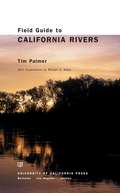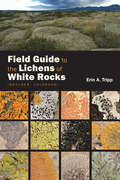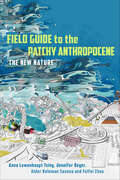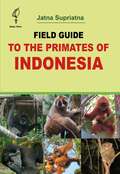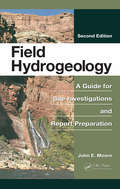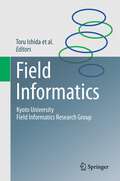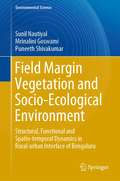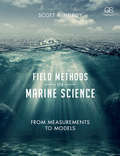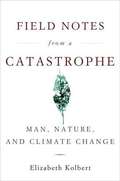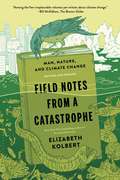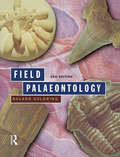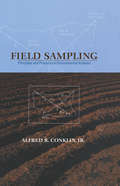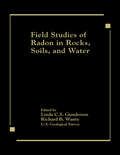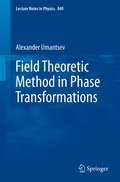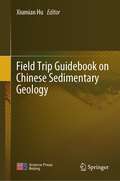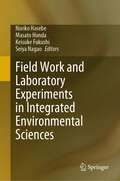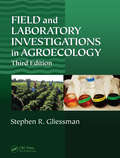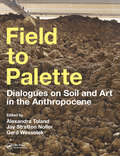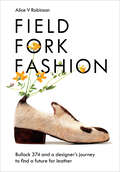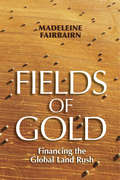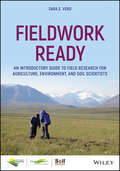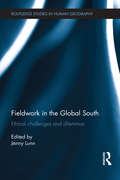- Table View
- List View
Field Guide to California Rivers
by Tim PalmerAward-winning author, naturalist, and conservationist Tim Palmer presents the world of California rivers in this practical and inspiring field guide. Loaded with tips on where to hike, fish, canoe, kayak, and raft, it offers an interpretive approach that reveals geology, plant and wild life, hydrologic processes, and other natural phenomena. Palmer reports on conservation with a perspective from decades of personal engagement. More than 150 streams are featured, 50 riparian species are illustrated, and 180 photos show the essence of California's rivers. Palmer brings a natural history guide, a recreation guide, and an introduction to river ecology together in one illuminating volume; it belongs in every river lover's book collection, boat, and backpack.
Field Guide to the Forest Trees of Uganda: For Identification and Conservation
by Alan Hamilton James KalemaThis book is a guide for the identification of the indigenous forest trees of Uganda. It will be useful for those who wish to contribute towards the conservation of the forests or to plant indigenous trees. Information is provided on how to propagate and cultivate about 80 of the most valuable species. Indigenous trees provide numerous resources useful for welfare and development. They include many types of timber and non-timber forest products, such as craft materials, foods and medicines. The proximity of indigenous forest helps to moderate the local climate, making it more suitable for agriculture. Indigenous forests protect springs, therefore safeguarding water supplies more effectively than exotic trees such as pines and eucalyptus. All 450 known indigenous tree species from the forests are included. Both scientific and local names are provided, the latter in 21 languages. Local names facilitate access to knowledge and values traditionally attached to the species, useful when planning pathways of development firmly rooted in local culture. The book will be invaluable for botanists, foresters, rural development workers and members of the general public concerned about contributing to conservation and sustainable development in Uganda. Many of the species grow in neighbouring countries, so the book has relevance there too.
Field Guide to the Lichens of White Rocks: (Boulder, Colorado)
by Erin TrippField Guide to the Lichens of White Rocks is a careful examination of the lichens that occur at the ecologically important and lichenologically rich urban outcropping of Fox Hills sandstone known as White Rocks Nature Preserve, located in Boulder County, Colorado. This extensively illustrated field guide presents detailed information on the macroscopic and microscopic features needed to identify species, as well as extensive notes on how to differentiate closely related lichens—both those present at White Rocks and those likely to be found elsewhere in western North America. This guide is one of the only complete lichen inventories of a sandstone formation in North America and covers all constituents including the crustose microlichen biota, traditionally excluded from other inventories. A short introduction and glossary equip the reader with basic information on lichen morphology, reproduction, and ecology. Visitors to White Rocks Nature Preserve must schedule staff-led public tours or set up sponsored research projects through the City of Boulder Open Space and Mountain Parks, and there are many other outcroppings of Fox Hills sandstone across the West, making Field Guide to the Lichens of White Rocks a significant resource for anyone interested in this unique environment. This accessible, user-friendly guide will also be valuable to naturalists and lichenologists around the world as well as educators, conservationists, and land managers concerned with the growing significance of open spaces and other protected urban areas throughout North America. The University Press of Colorado gratefully acknowledges the generous support of the University of Colorado Natural History Museum, City of Boulder Parks & Open Spaces, and the Colorado Native Plant Society board and members toward the publication of this book.
Field Guide to the Patchy Anthropocene: The New Nature
by Anna Lowenhaupt Tsing Feifei Zhou Jennifer Deger Alder Keleman SaxenaNature has gone feral. How can we re-attune ourselves to the new nature? A field guide can help. While the global scientific community recently made headlines by ruling the Anthropocene—an era many date to the Industrial Revolution when human action truly began to transform the planet—did not qualify for a geological epoch quite yet, understanding the nature of human transformation of the Earth is more important than ever. The effects of human activity are global in scope, but take shape within distinct social and ecological "patches," discontinuous regions within which the key actors may not be human, but the plants, animals, fungi, viruses, plastics, and chemicals creating our new world. Field Guide to the Patchy Anthropocene takes stock of our current planetary crisis, leading readers through a series of sites, thought experiments, and genre-stretching descriptive practices to nurture a revitalized natural history. Field guides teach us how to notice, name, and so better appreciate more-than-human worlds. They hone our powers of observation and teach us to see the world anew. Field-based observations and place-based knowledge cultivation—getting up-close and personal with patchy dynamics—are vital to truly grapple with the ecological challenges and the historical conjunctures that are bringing us to multiple catastrophic tipping points. How has commercial agriculture runoff given rise to comb jellies in the Black Sea? What role did the Atlantic slave trade play in the worldwide spread of virus-carrying mosquitoes? How did the green revolution transform the brown planthopper into a superpredator in Philippine rice fields? Questions like these open up new ways of understanding, and ways of living through, the epoch that human activity has ushered in. This Field Guide shifts attention away from knowledge extractive practices of globalization to encourage skilled observers of many stripes to pursue their commitments to place, social justice, and multispecies community. It is through attention to the beings, places, ecologies, and histories of the Anthropocene that we can reignite curiosity, wonder, and care for our damaged planet.
Field Guide to the Primates of Indonesia
by Jatna SupriatnaThis primate field guide can be used to refer to information on each species, or it can be used to find which species exist on each island, as shown at the back of the book. A list of primates in Indonesia is provided with local, English, and scientific names. Once the name is identified the user can go to the description of the genus and species. Also given is the conservation status of each species except for the most recently described, whose status is not yet known. The information on each species' natural history, behavior, ecology, and where to see it in parks and/or forested areas outside parks is included. Field Guide to the Primates of Indonesia primate drawings are by Stephen Nash and photographs were donated by many of the author's friends from Indonesia and abroad.
Field Hydrogeology: A Guide for Site Investigations and Report Preparation, Second Edition
by John E. MooreIn recent years, the focus in hydrogeologic investigations has expanded to include aquifer sustainability as part of resource evaluations. While there are other books on the subject, Field Hydrogeology: A Guide for Site Investigations and Report Preparation provides the first integrated presentation of the American Society of Testing Materials (AST
Field Informatics
by Toru IshidaHere we use the term "field" to refer to a sphere of practical operation, and correspondingly the term "field informatics" describes informatics tools and methodologies that arise in the field. The components of field informatics are description, prediction, design and transfer, and the methods for those components vary widely. For example, we consider the social goal of revitalizing a mountainous area experiencing depopulation and we show how the tools and methodologies of field informatics may be used to describe such situations using remote sensing, biologging, human sensing and ethnography; the effects of various solutions can be predicted using system dynamics and multiagent simulations; the solutions can be designed using inclusive design or participatory design methods; and finally the experience gained can be transferred using case writing and outreach communication. The authors are specialists in diverse areas such as informatics, engineering, agriculture, sociology and pedagogy, and their areas of interest range from environment conservation to social education for international cooperation. They have a particular focus on the environment in southeast Asia and related topics such as large-scale traffic simulations, participatory workshops, inclusive design workshops, distance learning, and intercultural collaboration. This book targets graduate students seeking tools and methodologies for natural observation, field workers engaged in social participation, and researchers and engineers pursuing innovation. The techniques described in the book could also be exploited by government officials to form consensus and develop activities or by non-profit organizations to undertake more effective social programs.
Field Margin Vegetation and Socio-Ecological Environment: Structural, Functional and Spatio-temporal Dynamics in Rural-urban Interface of Bengaluru (Environmental Science and Engineering)
by Sunil Nautiyal Mrinalini Goswami Puneeth ShivakumarThis book has been produced as a part of the project ‘Social-Ecological Systems at the Indian Rural-Urban Interface: Functions, Scales, and Dynamics of Transition’. It addresses transition processes in agriculture and society triggered by urbanization, focusing on Bengaluru as an example of a rapidly growing megacity in India. Adopting a holistic, multidisciplinary approach embedded within a social-ecological systems research framework, it explores how the physical and socio-economic landscapes have led to changes in economic priorities, which have overpowered ecological and traditional priorities with regard to ecosystem governance. Allowing readers to gain a deeper understanding of this unexplored dimension of socio-ecological systems, this book is a valuable resource for international researchers, scholars and master’s students in the field of environmental science, socio-ecology, forestry and agriculture.
Field Methods in Marine Science: From Measurements to Models
by Scott MilroyField Methods in Marine Science: From Measurements to Models is an authoritative guide of the methods most appropriate for field research within the marine sciences, from experimental design to data analysis. Written for upper-level undergraduate and graduate students as well as early-career researchers, this textbook also serves as an accessible introduction to the concepts and practice of modeling marine system dynamics. This textbook trains the next generation of field scientists to move beyond the classic methods of data collection and statistical analysis to contemporary methods of numerical modeling; to pursue the assimilation and synthesis of information, not the mere recording of data. Boxes and side bars highlight important questions, interesting facts, relevant examples, and research techniques that supplement the text. Students and researchers alike will find the thorough appendices useful as a way of expanding comprehension of fundamental concepts.
Field Notes from a Catastrophe: Man, Nature, and Climate Change
by Elizabeth KolbertAn argument for the danger of global warming in a book that is sure to be as influential as Rachel Carson's "Silent Spring," Known for her insightful journalism, "New Yorker" writer Elizabeth now tackles the controversial subject of global warming.
Field Notes from a Catastrophe: Man, Nature, and Climate Change
by Elizabeth KolbertThis description of the realities of global warming is a passionate plea for action whilst there is still time. The author approaches global warming from all angles, visiting the Artic, the North of England, Holland and Puerto Rico, interviewing researchers and environmentalists and explaining the science and the studies.
Field Palaeontology
by Roland Goldring"This is the major text on the integration of field palaeontology and sedimentology, particularly valuable for both practical lab exercises and students working independently and unsupervised on field projects"Reviewer's commentField Palaeontology provides a comprehensive, rigorous and unique approach to the analysis of fossils and sediments and offers a practical field guide which no palaeontology student can afford to be without.The past decade has seen immense changes in palaeontology and in the study of sedimentary rocks in general. This edition has been thoroughly revised to take into account these advancements in the subject to produce a book that is unique in its coverage of palaeontology and sedimentology. It aims to provide a basis for evaluating the information potential of fossiliferous sediments, and then to give an outline of the strategy and tactics whicn can be adopted in the field.Field Palaeontology is written for advanced undergraduate courses in palaeontology, palaeoecology, palaeobiology, sedimentology and biostratigraphy within geoscience and geology degrees. It is also useful reading for Masters earth science students and first year postgraduates looking for a grounding in the basics of the subject.
Field Sampling: Principles and Practices in Environmental Analysis (Books in Soils, Plants, and the Environment)
by Alfred R. Conklin Jr.Written by a renowned professional with more than 30 years of experience in environmental sampling and analysis, this reference describes in unparalleled detail all the essential elements for the development and execution of a successful sampling plan at both contaminated and uncontaminated sites. The book covers presampling planning and decision-making, specific sampling situations, and correct sample labeling, and presents the framework and background for the sampling of any contaminated site. Presenting a wide variety of models, quality control procedures, and valuable troubleshooting methods, Field Sampling contains an abundance of topics never before covered in any other source.
Field Studies of Radon in Rocks, Soils, and Water
by Linda C. Gundersen Richard B. WantyField Studies of Radon in Rocks, Soils, and Water focuses on the principal sources of indoor radon and detecting radon through geochemical and hydrological studies of ground water. The book addresses how to measure radon, covers geological field study techniques, and presents techniques for assessing radon potential. The geochemical and hydrological studies of ground water cover such areas as health effects and radionuclides in geology. Techniques for measuring radon in ground water are also provided. Field Studies of Radon in Rocks, Soils, and Water is an excellent practical guide for geologists, geochemists, ground water professionals, and geophysicists interested in radon.Features
Field Theoretic Method in Phase Transformations
by Alexander UmantsevThe main subject of the book is the continuum, field theoretic method of study of phase transformations in material systems. The method, also known as "phase field", allows one to analyze different stages of transformations on the unified platform. It has received significant attention in the materials science community recently due to many successes in solving or illuminating important problems. The book will address fundamentals of the method starting from the classical theories of phase transitions, the most important theoretical and computational results, and some of the most advanced recent applications.
Field Theories of Condensed Matter Physics
by Eduardo FradkinPresenting the physics of the most challenging problems in condensed matter using the conceptual framework of quantum field theory, this book is of great interest to physicists in condensed matter and high energy and string theorists, as well as mathematicians. Revised and updated, this second edition features new chapters on the renormalization group, the Luttinger liquid, gauge theory, topological fluids, topological insulators and quantum entanglement. The book begins with the basic concepts and tools, developing them gradually to bring readers to the issues currently faced at the frontiers of research, such as topological phases of matter, quantum and classical critical phenomena, quantum Hall effects and superconductors. Other topics covered include one-dimensional strongly correlated systems, quantum ordered and disordered phases, topological structures in condensed matter and in field theory and fractional statistics.
Field Trip Guidebook on Chinese Sedimentary Geology
by Xiumian HuThis book provides diversified and comprehensive sedimentary, stratigraphic, and paleontological information services in China both for scientific research and educational purposes. Although China has the largest number of 11 “golden nails” profiles in the world, few of them has internationally renowned profiles with only traditional sedimentary methods and means for outcrops, logging, and seismic analysis. It combines multiple disciplines such as sedimentology, stratigraphy, paleontology, geophysics, geochemistry, and methods such as big data and artificial intelligence to build open-source online digital platform of geological profiles. Based on the preparation and construction of a number of well-known classic sections of sedimentary geology at home and abroad, it has become an important platform for training of sedimentology talents.
Field Work and Laboratory Experiments in Integrated Environmental Sciences
by Seiya Nagao Noriko Hasebe Masato Honda Keisuke FukushiThis book introduces the variety of research skills necessary for integrated environmental science, which are applicable to atmospheric, oceanic, terrestrial, and biota studies. The surface environment of the earth is a complex system consisting of atmospheric, oceanic, and terrestrial regions as well as the biota therein, all of which interact with one another to various extents. The integration of research disciplines including earth science, biology, chemistry, physics, and social science is a core of environmental science. It encourages students and early-career scientists to take a broad view of the whole environmental system. Detailed practical information for the field or laboratory work in this book helps students and scientists to plan research strategy for their own scope and interests. In addition, this book is also useful for professionals to teach field and laboratory work in environmental science to students. This book is based on the environmental summer school program organized by the Institute of Nature and Environmental Technology, Kanazawa University, in Japan.
Field and Laboratory Investigations in Agroecology
by Stephen R. GliessmanAgroecology is defined as the application of ecological concepts and principles to the design and management of sustainable food systems. Hence, learning can best be achieved through an experiential approach to the topic. Designed to accompany Agroecology: The Ecology of Sustainable Food Systems, Third Edition, Field and Laboratory Investigations i
Field to Palette: Dialogues on Soil and Art in the Anthropocene
by Alexandra Toland Jay Stratton Noller Gerd WessolekField to Palette: Dialogues on Soil and Art in the Anthropocene is an investigation of the cultural meanings, representations, and values of soil in a time of planetary change. The book offers critical reflections on some of the most challenging environmental problems of our time, including land take, groundwater pollution, desertification, and biodiversity loss. At the same time, the book celebrates diverse forms of resilience in the face of such challenges, beginning with its title as a way of honoring locally controlled food production methods championed by "field to plate" movements worldwide. By focusing on concepts of soil functionality, the book weaves together different disciplinary perspectives in a collection of dialogue texts between artists and scientists, interviews by the editors and invited curators, essays and poems by earth scientists and humanities scholars, soil recipes, maps, and DIY experiments. With contributions from over 100 internationally renowned researchers and practitioners, Field to Palette presents a set of visual methodologies and worldviews that expand our understanding of soil and encourage readers to develop their own interpretations of the ground beneath our feet.
Field, Fork, Fashion: Bullock 374 and a Designer's Journey to Find a Future for Leather
by Alice V RobinsonFrom one of the 2023 Vogue Business 100 Innovators List"[T]his wonderful project and book, executed with great charm and creativity, is an important message." Anya HindmarchIn this personal investigation into ethical and traceable leather, fashion designer Alice Robinson begins a ground-breaking journey into the origin story of leather and its connection to food and farming.As a fashion student, Alice started to question the material she worked with. Leather is universally acknowledged as a luxury material, from which desirable bags, shoes and clothing are made. But how much do we know about where it comes from?Alice&’s questions led back to her childhood home in rural Shropshire, where she decided to buy Bullock 374 and follow its journey from a local farm to the abattoir, then to the butchery and finally to the tannery. The journey culminates with Alice&’s own design practice as she creates a collection based on this single hide.In doing so, Alice would begin to see the bigger picture – and connect farm, food and fashion for the first time to understand the true meaning of provenance, value and beauty.
Field, Fork, Fashion: Bullock 374 and a Designer’s Journey to Find a Future for Leather
by Alice V Robinson*From one of the Vogue Business 100 Innovators List - 2023 "[T]his wonderful project and book, executed with great charm and creativity, is an important message." Anya Hindmarch In this personal investigation into ethical and traceable leather, fashion designer Alice Robinson begins a ground-breaking journey into the origin story of leather and its connection to food and farming. As a fashion student, Alice started to question the material she worked with. Leather is universally acknowledged as a luxury material, from which desirable bags, shoes and clothing are made. But how much do we know about where it comes from? Alice’s questions led back to her childhood home in rural Shropshire, where she decided to buy Bullock 374 and follow its journey from a local farm to the abattoir, then to the butchery and finally to the tannery. The journey culminates with Alice’s own design practice as she creates a collection based on this single hide. In doing so, Alice would begin to see the bigger picture – and connect farm, food and fashion for the first time to understand the true meaning of provenance, value and beauty.
Fields of Gold: Financing the Global Land Rush (Cornell Series on Land: New Perspectives on Territory, Development, and Environment)
by Madeleine FairbairnFields of Gold critically examines the history, ideas, and political struggles surrounding the financialization of farmland. In particular, Madeleine Fairbairn focuses on developments in two of the most popular investment locations, the US and Brazil, looking at the implications of financiers' acquisition of land and control over resources for rural livelihoods and economic justice. At the heart of Fields of Gold is a tension between efforts to transform farmland into a new financial asset class, and land's physical and social properties, which frequently obstruct that transformation. But what makes the book unique among the growing body of work on the global land grab is Fairbairn's interest in those acquiring land, rather than those affected by land acquisitions. Fairbairn's work sheds ethnographic light on the actors and relationships—from Iowa to Manhattan to São Paulo—that have helped to turn land into an attractive financial asset class.
Fieldwork Ready: An Introductory Guide to Field Research for Agriculture, Environment, and Soil Scientists (ASA, CSSA, and SSSA Books)
by Sara E. VeroDiscover how to plan, conduct, and interpret field research with this essential new guidebook Good field research is the driving force behind advancement in the agronomic, environmental, and soil sciences. Nevertheless, many undergraduate and graduate scientists have limited opportunity to develop hands-on experience before undertaking projects in the field. With Fieldwork Ready, Dr Sara Vero maps out the fundamental principles, methods, and management techniques that underpin this crucial practice, offering trainee researchers an accessible introduction to the world of on-site investigation. This instructive text includes: Guidance on the essential aspects of environmental monitoring and soil, water, plant, and wildlife research Insights into the methods behind experiment planning and effective fieldwork Tips for team management and safety Explanations of how to select and correctly use soil sampling equipment Offering new researchers a primer that is practical and easy to follow, Fieldwork Ready is the ideal starting point for all those beginning a career in the agricultural sciences.
Fieldwork in the Global South: Ethical Challenges and Dilemmas (Routledge Studies in Human Geography)
by Jenny LunnChoosing to do fieldwork overseas, particularly in the Global South, is a challenge in itself. The researcher faces logistical complications, health and safety issues, cultural differences, language barriers, and much more. But permeating the entire fieldwork experience are a range of intermediating ethical issues. While many researchers seek to follow institutional and disciplinary guidelines on ethical research practice, the reality is that each situation is unique and the individual researcher must negotiate their own path through a variety of ethical challenges and dilemmas. This book was created to share such experiences, to serve not as a manual for ethical practice but rather as a place for reflection and mutual learning. Since ethical issues face the researcher at every turn and cannot be compartmentalized into one part of the research process, this book puts them at the very center of the discussion and uses them as the lens with which to view different stages of fieldwork. The book covers four thematic areas: ethical challenges in the field; ethical dimensions of researcher identity; ethical issues relating to research methods; and ethical dilemmas of engagement with a variety of actors. This volume also provides fresh insights by drawing on the experiences of research students rather than those of established academics. The contributors describe research conducted for their master’s degrees and doctorates, offering honest and self-critical reflections on how they negotiated ethical challenges and dilemmas. The chapters cover fieldwork carried out in countries across Africa, Asia, and Latin America on a broad sweep of development-related topics. This book should have wide appeal to undergraduates, postgraduates, and early-career researchers working under the broad umbrella of development studies. Although focused on fieldwork in the Global South, the discussions and reflections are relevant to field research in many other countries and contexts.
